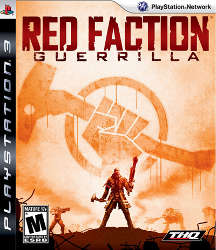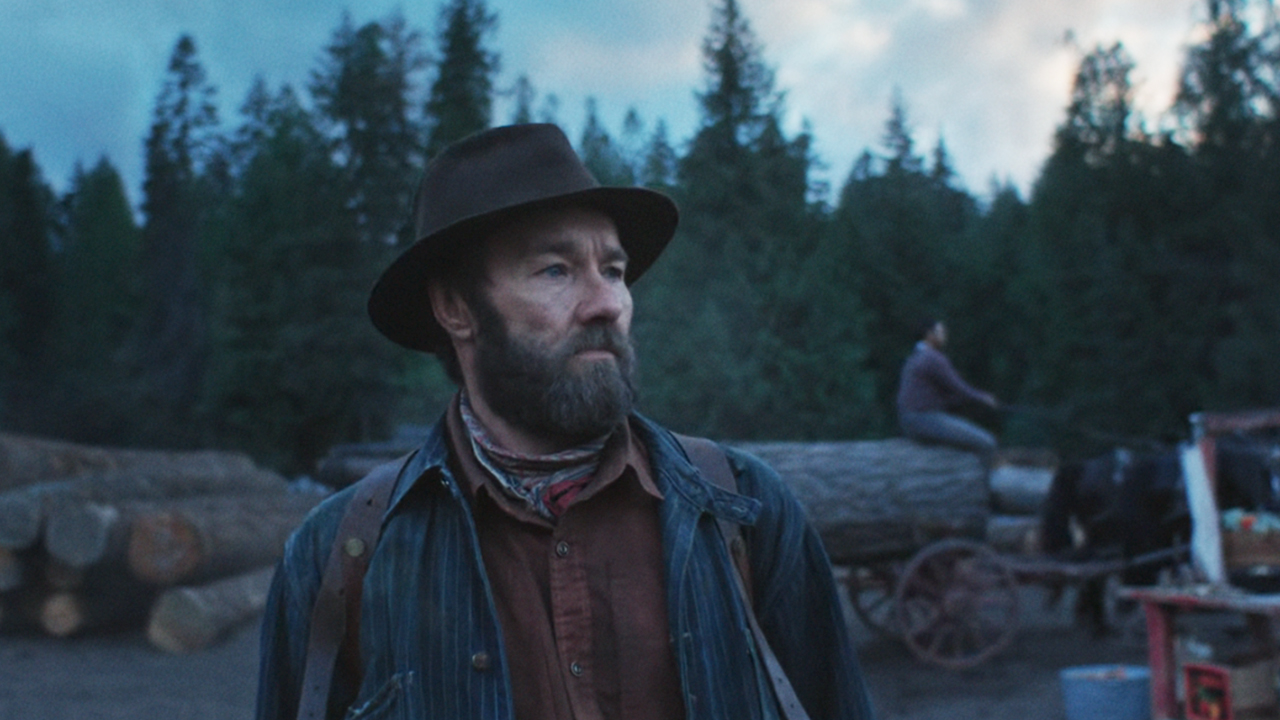
The philosophy of the Red Faction series, if it had to be boiled down to a single sentence, would be this: "Breaking stuff is fun." The first installment in the series, released in 2001, was one of the first games to feature destructible environments. With Red Faction: Guerrilla, Volition utilizes next-gen technology to take destruction to new heights and the result is a game that's a lot more fun than it ought to be.
Guerrilla is set fifty years after the first RF game. The Earth Defense Force, which helped residents of Mars rid themselves of the evil Ultor Corporation decades ago, has in turn become an oppressor. Players control Alec Mason, a miner who joins the rebellion ("The Red Faction") after being on the planet for a good ten minutes. It's a very unremarkable plot but at least you're not forced to wade through a lot of exposition to get to the wider game.
The Martian landscape is broken up into six regions, each of which measured by two meters: Control and Morale. Morale, which indicates how rebellious the region's populace is, starts at 0 but builds up as you "stick it to the Man" by destroying EDF installations or killing their troops. The higher the population's morale, the higher the probability that random colonists will show up during battles to help you. You'll also find more ammo in caches and get more salvage from destroyed buildings when their Morale's up. On the flipside, killing colonists will lower their Morale. Those of you who played Volition's other game Saints Row might think you'll be tempted to kill these hapless bystanders but Mars is not exactly crowded and civilians will literally give you their car if you try to enter it. Why bother attacking someone so helpful?
The Control meter measures how tight the EDF's grip is on that particular part of Mars. You need to bring Control down to zero and complete all the story missions in the region (there's usually only four or so) before you get a final mission to liberate that area once and for all. Getting the control meter down to zero requires you to do some side work, either optional missions or simply blowing up valued EDF installations. Depending on what type of optional mission you complete, you can also earn Morale or Salvage (the game's currency, used to purchase upgrades and unlock new weapons).
Saints Row and its sequel use a similar system ("Respect" was the name of the metric, there) to force you to engage in side missions. There was a lot more variety in SR's side tasks than in Guerrilla's, though. With Guerrilla, the side missions involve attacking an EDF base, defending a Red Faction base, rescuing Red Faction members, ambushing EDF vehicles. Strangely enough, there are also a few time trial races with vehicles. The only one of the elective missions that offers anything special are the demolition tasks. You're given a couple weapons and limited ammo and tasked with completely leveling a nearby building. Sound kind of boring? Well, it would be in any other game.
Guerrilla lets you dismantle a building piece by piece with a variety of explosive weapons, a nanorifle that disintegrates matter, or the trusty sledgehammer you always carry around. You rip support beams from the building and punch holes through walls and eventually can bring entire structures down to the ground. The condition of the building is noted on the minimap as a percentage. What's neat is that the destruction seems to conform to actual physics (more or less). Ceilings will cave in if you take down the beams below it and the structure topples a lot quicker if you target pillars rather than just smashing random walls. There's generally a delay between the building taking damage and its collapse, too, as if it's straining to stand then finally topples from gravity. This delay, as well as the game's third-person perspective, give you a chance to admire your destruction mroe easily. One complaint I had with destruction is the collecting of scrap. Scrap, as mentioned earlier, is the currency of the game and you pick it up from the rubble of destroyed structures. I often wondered why the game makes you go around fetching all these little pieces, though. Couldn't the scrap have been automatically added to my stockpile whenever I broke a section of building?
You won't just dismantle structures on foot. While driving the rovers, trucks, and other bulky vehicles through the Mars isn't all that thrilling, it is fun to drive these vehicles through the wall of a building. The game also has a few walkers - 10-20 foot tall mech suits that you can use to literally run through structures, Incredible Hulk style. Granted, you can't really see what you're doing when you're gutting a building - the camera's tight on your back - but it's not really a moment that requires strategy or any sort of thought. The walkers are extremely powerful (to excess, really) so the EDF takes awhile to wear you down when you're piloting one. Just run into a building, mash the buttons controlling your mech's arms and revel in the mindless "pig in slop" quality of the destruction.
Your Daily Blend of Entertainment News
Buildings are unfortunately the only thing worth damaging in the game. You can't actually dent the terrain of Mars at all, which is unfortunate because there's so many damn hills and mountains. Vehicles blow up but not in a satisfying piecemeal way. It doesn't seem like there's any sort of location-specific damage ruling these vehicles so they only have three states: perfect condition, about to blow up, or blown up. The game's isn't gory so shooting EDF troopers just makes them crumple to the floor like a training dummy - blah. Don't get me wrong, the basic shooter mechanics were fine and the weapons sounded/looked good in action but it was just a lot less fun than playing demolitionist.
That same "I'm only having fun if I blow up a building" rule applied to the story missions, too. The problem, though, is that even on the good story missions ("hey, go blow up those fuel depots"), it didn't feel like much effort was put into their design They're pretty basic tasks - destroy three of these, kill that guy, escort this vehicle, man the turret - and there's rarely any curveballs thrown at you. I guess what I was expecting from the story missions was an experience distinguishable from normal, free form gameplay. It's all well and good to make a game that's open-ended but toss us something a tightly scripted encounter once in a while, won't you?
The way I ultimately look at the single-player experience is this: it's an extended introduction to the multiplayer. While you could probably spend a few dozen hours in single-player by doing all the little extra tasks and getting expert times on the races and demolition tasks, it just didn't appeal to me. Mars is just too bland - most of the regions are nearly indistinguishable from each other - to make me want to stay there any more than I needed to. Thus, after racing through the single-player campaign, it was time to check out the multiplayer offering.
Before talking about the online offering, it's worth noting that Guerrilla has a local multiplayer option as well. In Wrecking Crew, you and your friends take turns causing as much destruction as you can within a certain time limit. Kudos to Volition for both offering a local multiplayer component and giving players a way to quickly jump into the highlight of the game - smashing buildings.
You can play Guerrilla online with up to 15 other players, depending on the mode. The simple fact that you're trading gunfire with human opponents instead of mindless waves of EDF troopers already makes it better than the single-player. There's another bigger reason why multiplayer's so fun, though: the backpacks. Throughout each multiplayer map, there are small kiosks with backpacks that grant you a special ability such as invisibility, a damage boost, or x-ray vision. There's not one but two jetpacks: one is better for prolonged flights while the other ("Thrust") gives you a short but powerful burst upward, allowing you to smash through walls and ceilings. There's also a Rhino backpack that generates a cone of force in front of you, throwing a hapless enemy or smash through walls like a mech. You can only carry one of these backpacks at a time but they can be reused over and over (with a short cooldown between uses) so basically everyone will have one of these on their back at any given time and it adds extra flavor to the usual multiplayer dueling.
Guerrilla's multiplayer offers up the usual deathmatch ("Anarchy"), team deathmatch ("Team Anarchy"), and capture the flag trifecta as well as three new modes that emphasize blowing up stuff. In Siege, two teams take turns trying to destroy a target while their opponents try to stop them. Damage Control is a capture-and-defend type of game in which you must destroy an enemy structure on a control point and then build your own in that same location. In Demolition, players from each team take turns being the Destroyer, who can rack up points for his team by demolishing structures and must be protected from enemies.
The appeal of Guerrilla's multiplayer isn't rooted in the new modes but in how the backpacks and destructible environments alter the fundamental online shooter experience. Winning a Capture the Flag match, for example, isn't just a matter of camping two entrances to the flag room; an enemy can just smash through whatever walls are between him and the flag and then leave just as easily. Between the jetpack, x-ray vision, the railgun (essentially a sniper rifle that can see/fire through walls), and the brittle walls, there's really no hiding from a fight. Your sledgehammer, your default melee weapon, can kill with one hit so there's a lot of close-quarters combat as well. Playing online in Guerrilla is a fast-paced, chaotic experience.
Each match earns you experience points that unlock extras. While it's nice that you'll get about one unlockable per match, a lot of these unlockables are just small cosmetic touches - character models, different colors/icons for your personal badge, skins for your sledgehammer - or simply new methods for earning new experience points. For example, after a few hours of multiplayer, I gained the ability to earn additional experience points by collapsing buildings on enemies. These little changes are fun and create a game-within-a-game but I can't get excited over earning the right to have an aqua-colored character badge.
I really wish the single-player campaign had been complete enough to measure up to the online offering. Still, even in the single-player, there's something about Guerrilla that turns me back to my ant-burning prepubescent phase. It's so much damn fun to bashing a building with a sledgehammer until it falls over, even if there's no reward whatsoever for doing so. The reasons that the game is enjoyable are basic but undeniable. It offers gleeful destruction with a minimum of technical issues and it's tough not to recommend it to a fan of the genre. In a crowded shooter market filled with bald-faced imitation, Guerrilla succeeds in setting itself apart.
Players:1-16
Platform(s):PS3 (reviewed), Xbox 360, PC
Developer:Volition Inc.
Publisher:THQ
ESRB:T for Teen
Rating:

Staff Writer at CinemaBlend.

